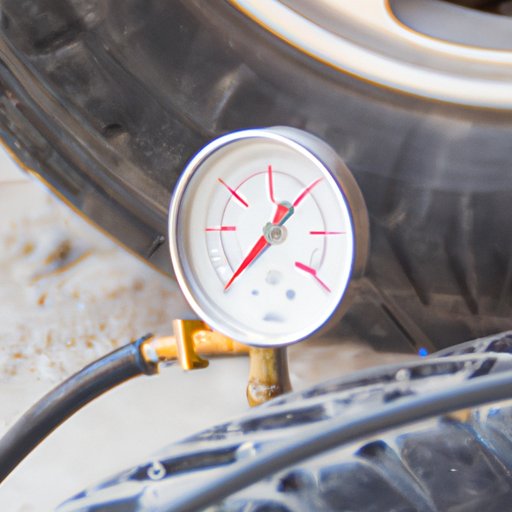
Introduction
Maintaining proper tire pressure is essential for optimal safety, performance, and fuel efficiency on the road. But how do you know if your tires are properly inflated? And how do you fill them up with air? This article will guide you through the process of filling tires with air and provide you with tips on tire maintenance for optimal performance.
Step-by-Step Guide: Filling Tires with Air
The first step to filling your tires with air is to determine the recommended air pressure for your vehicle. This information can often be found in your owner’s manual or on a sticker located on the driver’s side door.
Once you know the recommended air pressure, you’ll need a tire pressure gauge to check your tire’s current pressure. Simply press the gauge against the tire valve until you hear a hiss, then read the pressure level. If it’s below the recommended level, it’s time to fill up your tires with air.
An air compressor will be necessary to fill your tires with air. Many gas stations offer air compressors, but you can also purchase a portable air compressor for home use. Once you have the air compressor, attach the nozzle to the tire valve and turn it on. Allow the tire to fill up with air, periodically checking the pressure level with your tire pressure gauge. Be careful not to overfill your tires, as this can be just as detrimental to your vehicle as under-inflated tires.
Finally, after filling your tires with air, make sure they are properly inflated. Double-check the pressure levels with your tire pressure gauge, and ensure all tires are filled to the recommended level.
Video Tutorial: How to Fill Tires with Air
If you prefer a visual walkthrough of how to fill tires with air, check out this video tutorial. This tutorial will walk you through the process step-by-step and provide you with tips and tricks for easy tire maintenance.
Infographic: Steps to Fill Tires with Air
For an easy reference guide to filling your tires with air, check out this infographic. The infographic provides a visual representation of the steps outlined in this article, along with key tips and reminders for proper tire maintenance.
Understanding Tire Pressure
Proper tire pressure is essential for optimal safety and performance on the road. Low tire pressure can negatively impact fuel efficiency, tire wear, and vehicle safety. Regular tire maintenance, including checking and maintaining proper tire pressure, is important for optimal vehicle performance.
To check your tire pressure, use a tire pressure gauge and consult your vehicle manual for recommended pressure levels. It’s important to regularly check your tire pressure, particularly before long trips or when driving conditions change.
Choosing the Right Equipment
To properly fill your tires with air, you’ll need the right equipment. Tire pressure gauges can vary in accuracy and ease of use, so research different types to find the right gauge for your needs. Portable air compressors can vary in price and functionality, so consider your budget and intended use before purchasing one.
Some popular tire pressure gauges include the Accutire MS-4021B and the TEKTON 5941 Digital Tire Gauge. For air compressors, consider the VIAIR 85P Portable Air Compressor or the Kensun AC/DC Portable Air Compressor.
Common Mistakes to Avoid When Filling Tires with Air
When filling your tires with air, it’s important to avoid common mistakes that can negatively impact tire pressure and vehicle performance. One common mistake is failing to check tire pressure regularly, particularly before long trips. Another mistake is overfilling or under-filling your tires, which can result in poor handling and decreased fuel efficiency. Finally, make sure to check for damage to your tires, such as punctures or wear, which can impact tire pressure and performance.
Conclusion
Filling your tires with air may seem like a simple task, but it’s an essential part of maintaining proper tire pressure for optimal vehicle performance and safety. Regular tire maintenance, including checking tire pressure and filling tires with air, can improve fuel efficiency, tire wear, and overall vehicle performance. By following the steps outlined in this article, and avoiding common mistakes, you can ensure your tires are properly inflated and ready for the road ahead.




